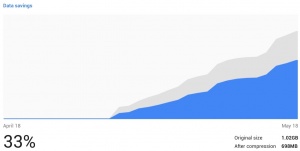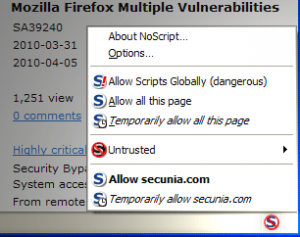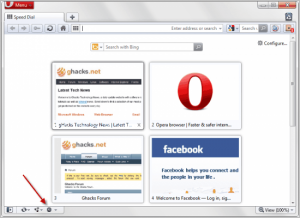Tips for Dial-up
This page contains tips for dial-up users and DSL subscribers with a slow connection.
Introduction
Few websites these days are designed for the slow connection of dial-up users.
Turning off images can enable web pages to display much faster however sometimes graphics are required to navigate web pages. The web browser add-ons and extensions listed below add a button to turn graphics on and off.
Opera web browser has an optional turbo mode for slow connections that compresses a web page by up to 80% before sending it. Opera claims web pages may load up to four times faster although this may quite optimistic in actual day-to-day use. Google's Chrome browser now has a similar method known as Data Saver. The Chrome data saver is likely to work better than Opera's Turbo because Google has many more servers and therefore should have reduced latency.
There are a number of web browser extensions that can speed up the loading of websites by blocking bandwidth heavy items such as Flash and advertisements. Internet Explorer, Firefox, Chrome, Opera and Internet Explorer users can install Adblock Plus. With the appropriate web browser extension, some websites can provide their mobile web pages that are much lighter and quicker to load than the standard web pages.
For dial-up users there's no need to tie up your telephone line when reading or replying to email. By installing a mail client instead of using a web browser (webmail) you can connect, download your mail and then disconnect. Once your done reading and responding to your mail while offline you can reconnect to quickly send it off.
Lots of programs work in the background looking for updates. Take control of your software updates.
Note: A number of folks have had problems with dial-up networking no longer working after upgrading to Windows 10 which then required a rollback or re-installation of the previous Windows operating system version.
Chrome web browser
- Google Chrome home page
- Available for Windows, Mac and Linux computers.
How to toggle on or off web page images, pictures and graphics in Chrome
Turning off images can enable web pages to display much faster. Be aware that you may encounter some web sites that do not display alternative text for navigation of button bars etc., however the toggle button makes it an easy fix for those exceptions.
- Block Image - extension
- Block images and videos.
- Prevent images from "Downloading".
- You can toggle blocking on/off by clicking the extension icon button on the chrome toolbar.
Advanced users can use Chrome's own settings to allow or block images per website by going to Chrome's settings → Content Settings → Images → Manage Exceptions.
Adblock Plus
Advertisements can make web pages load slowly. Adblock Plus does a good job at blocking ads, banners and pop-ups.
Flashcontrol
With Flashcontrol installed, web content that requires Flash plugins will be disabled by default. You then enable content by clicking on a blocked area on any given webpage.
Use mobile versions of websites
By installing User Agent Switcher for the Chrome browser you can automatically have the much lighter and faster mobile versions of web site provided to you.
Here's an alternative: User-Agent Switcher. Just right click on any page and select your user-agent. Selecting an Android option would provide a mobile website (if one is available).
Data Saver
There is a new feature available for Chrome users called Data Saver. When this extension is enabled, Chrome will use Google servers to compress pages you visit before downloading them. This technology should reduce page loading times. Secure sites like banking are not routed through Google servers and will not be compressed. More on the technology.
You can use a beta version of the Data Saver extension if you're running Chrome version 41 or higher. To turn on Data Saver:
- Install the Data Saver extension from Chrome Web Store. (free)
- Data Saver should be turned on by default. If it is not, click Turn On Data Saver.
To turn off Data Saver:
- In the menu bar, click the Data Saver icon Data Saver icon.
- Click Turn Off Data Saver.
Firefox web browser
- Firefox home page
- Available for Windows, Mac and Linux computers.
How to toggle on or off web page images, pictures and graphics in Firefox
Turning off images can enable web pages to display much faster. Be aware that you may encounter some web sites that do not display alternative text for navigation of button bars etc, however the toggle button makes it an easy fix for those exceptions. The toggle button is added to the navigation toolbar (extreme right) by default.
Use mobile versions of websites
By installing User Agent Switcher for the Firefox browser you can automatically have the much lighter and faster mobile versions of web site provided to you. (Doesn't work with Firefox 57 and later)
Here's an alternative user agent switcher. (Doesn't work with Firefox 57 and later)
Install Adblock Plus
Advertisements can make web pages load slowly. Adblock Plus does a good job at blocking ads, banners and pop-ups.
As of Firefox 57 Quantum, the browser includes its own native ad blocker, called "Tracking Protection", that can be configured at Preferences → Privacy & Security → Tracking Protection.
Install Flashblock
On dial-up you likely don't want Adobe Flash installed but if you require it there is a way to automatically block flash objects on web pages and selectively view them. (Doesn't work with Firefox 57 and later)
Optionally install NoScript for Firefox
The NoScript Firefox extension allows you to block JavaScript, Java, Flash and other plugins. This can enable a web page to load much faster. NoScript also helps prevent web pages from running potentially malicious programs. You can enable JavaScript, Java and plugin execution for sites you trust with a left-click on the NoScript status bar icon.
Opera web browser
- Opera home page
- Available for Windows, Mac and Linux computers.
When Opera Turbo is enabled, web pages are compressed via Opera's servers so that they use much less data than the originals. This means that there is less to download, so you can see your web pages more quickly. Improvements in page load speed should be seen by those using dial-up or a slow DSL connection.
How to toggle on or off web page images, pictures and graphics in Opera
Turning off images can enable web pages to display much faster. Be aware that you may encounter some web sites that do not display alternative text for navigation of button bars etc., however the toggle button makes it an easy fix for those exceptions. Opera provides guidance on displaying images on their help page.
There is also an extension available named Images ON/OFF for Opera. It adds an image toggle button in the upper right corner.
Install Adblock Plus
Advertisements can make web pages load slowly. Adblock Plus does a good job at blocking ads, banners and pop-ups.
Another way to speed up web browsing with Opera is to go to open Preferences → Advanced → Content and tick "Enable plugins only on demand".
Opera Turbo
Opera turbo uses data compression to speed up loading of web sites. To enable Opera Turbo click the Opera Turbo icon at the bottom-left of the Opera browser window. If you are using a laptop and switch to a fast connection at another location Opera Turbo is no longer required and, turbo mode is automatically disabled.
Opera browser will automatically disable Turbo on secure websites (HTTPS connections) like financial banking sites, Facebook, Twitter.
Getting Opera
The following are links to the latest versions of Opera.
- Windows 95/98/Me/NT 4.0 10.63
- Windows 2000 12.02
- Windows XP to Windows 8
- Mac current version
- Mac older versions
- Linux
Internet Explorer
The Chrome, Firefox or Opera browser are a preferred choice over Internet Explorer.
How to turn off web page images, pictures and graphics in Internet Explorer
Turning off images can enable web pages to display much faster. Be aware you may encounter some web sites that do not display alternative text for navigation of button bars etc. Reverse the steps below to re-enable images.
- Step 1: Open the Microsoft Internet Explorer "Tools" menu and choose "Internet Options." When the Internet Options dialog box opens, click on the "Advanced" tab.
- Step 2: Scroll through the Settings box to the Multimedia section. Turn off the check box in front of "Show Pictures."
- Step 3: Click on the "Apply" button to change your settings. Internet Explorer will not load the pictures on the next site or page you visit.
Install Adblock Plus
Advertisements can make web pages load slowly. Adblock Plus does a good job at blocking ads, banners and pop-ups. More information.
UAPick User-Agent Switcher
Requirements: Internet Explorer 8, 9 or IE10/IE11 (Desktop mode only)
"This little add-on allows you to quickly customize the User-Agent string sent by Internet Explorer without restarting. After installing, click "Set User-Agent String" on the classic Tools menu to launch the add-on. The new User-Agent will remain in effect until you reverse the change with the add-on, or restart the IE process."
UAPick Internet Explorer 10+ issues
Notes: "Please note that this add-on only works in Internet Explorer on the desktop, not in the full-screen experience previously known as "Metro." Metro-IE does not support add-ons of any type." Note: also not supported by Microsoft Edge web browser.
"This add-on also presently only works when Enhanced Protected Mode (EPM) is disabled; see Tools → Internet Options → Advanced → Security. EPM is disabled by default for IE10 and enabled by default in IE11. This limitation can be fixed in the future, but requires an update to the code." (Note: There are no further updates to any version of IE)
Microsoft's information and guidance on turning off Enhanced Protected Mode Enhanced Protected Mode helps protect your PC and personal data from malware and other attacks. When it's turned on, add-ons such as toolbars, extensions, and browser helper objects can only run if they're compatible with Enhanced Protected Mode. You'll be notified if an add-on is incompatible. If you need to run an incompatible add-on, you can turn off Enhanced Protected Mode in the desktop browser.
Microsoft Edge
The Edge browser now supports add-ons. You can also:
- Turn off Flash video
- Click the menu button in Edge. It is the three dots in the upper right corner.
- Select Settings from the menu.
- Click the "View advanced settings" button. You will have to scroll down to locate it.
- Switch "Use Adobe Flash Player" to off.
Lynx Web Browser
Lynx is a text-based web browser. Lynx does not support graphics. Lynx does not support JavaScript and Adobe Flash, which some websites require to work correctly.
Dillo Web Browser and D+ Browser
These are graphical browsers with a small footprint that do not run Flash, Javascript, or Java.
Email for dial-up
Try using mail client software rather than web mail. You can then read and compose mail offline.
Mozilla Thunderbird
Thunderbird is a fully featured mail client available for Windows, Mac OS X and Linux.
Here are instructions to set up Thunderbird for IMAP.
If you set Thunderbird up for POP3, Thunderbird will download your email to your computer and delete the mail off the server. If you choose IMAP your mail remains on the server. POP3 works best for offline use.
To setup Thunderbird for POP3, select "manual config" during the account configuration and under "incoming" select "POP3".
Email Quick Configuration Info
|
nPOPuk alternate email client
nPOPuk is very small but full featured email software for Windows.
Take control of your software updates
Consider changing your Windows update settings in Control Panel to check for updates but let you decide when to download them. Microsoft releases updates on the second Tuesday of the month.
Consider changing Firefox's update settings to check for updates but let you decide when to download them. Open Firefox → Firefox button at the top left corner of the screen → Options → advanced → update.
Set Adobe Reader to not automatically download updates. Open Adobe reader Edit → Preferences → Updater.
Set Java to notify you but not automatically download updates. If Java is installed you will find it in the Control Panel. If you don't use java, uninstall it.
For Windows users, Adobe Flash player settings can be found in Control Panel. You could set it to notify you of updates but not automatically download and install them.
Set your antivirus software to notify you but not automatically install updates.
Some Dialup-Friendly Links
There are still a few web sites with pages small enough to load fairly quickly on dial-up connections. The following pages, as of 2018-06-01, have some dialup-friendly links:
- This page was originally written by NCF Board Member Graeme Beckett




